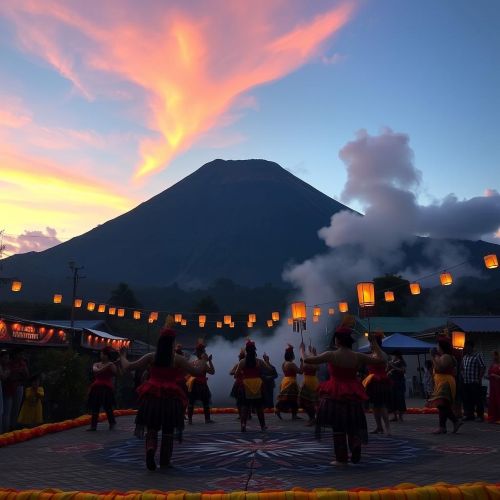Nyepi : The Silent Festival
At a glance
| Description | |
|---|---|
| Location | Bali |
| Country | Indonesia |
| Dedicated To | Hyang Widi Wasa |
| Duration | 1 day |
| Time of Year | March |
Introduction
In the heart of Indonesia, amidst Bali’s lush landscapes and vibrant traditions, there exists a New Year celebration like no other. Nyepi, often referred to as the Day of Silence, marks the beginning of the Saka New Year on the Balinese Hindu calendar. But instead of fireworks, music, or countdowns, the entire island comes to a standstill. Streets are empty, lights are off, and the only sounds heard are those of nature. It’s a powerful moment of collective pause, rooted in centuries of spiritual practice and cultural wisdom.
This day isn’t about spectacle — it’s about stillness. Nyepi invites everyone, locals and visitors alike, to disconnect from the external world and turn inward. For 24 hours, Bali becomes a living embodiment of introspection and spiritual renewal.
Connection with Mythology
Nyepi isn’t just about quietude; it’s deeply tied to mythology and ancient beliefs. Balinese Hindus view it as a symbolic victory of good over evil — a cosmic reset. The stories that underpin the festival speak of the eternal dance between darkness and light, reminding participants of the constant need to maintain harmony within themselves and the universe.
One fascinating aspect is the idea of tricking negative spirits. According to traditional belief, by making the island appear deserted and lifeless for a day, malevolent forces are fooled into leaving, allowing Bali to start its new year on a cleansed and protected note. This idea speaks to the interconnectedness of spirit, nature, and community that defines Balinese Hinduism.
Main Activities
Nyepi is preceded by several days of ceremonies that prepare both the spiritual and physical worlds for the year ahead. One of the most visually striking is the Ogoh-Ogoh parade, held the night before. Enormous demon-like effigies made by local youth groups are paraded through the streets in a festive, noisy ritual. These grotesque and colorful figures represent negativity and chaos. Once the parades conclude, the effigies are burned in a symbolic act of purification, clearing the path for a fresh start.
Another key event is Melasti, a beautiful water purification ceremony. Temples bring their sacred heirlooms to the sea or rivers, cleansing them and restoring spiritual energy. It’s a powerful reminder of the Balinese belief that water is life — not just physically, but spiritually as well.
Then comes the main event: 24 hours of complete silence. The rules of Nyepi are rooted in the practice of “Catur Brata Penyepian,” four principles of abstention. No fire or electricity, no work, no travel, and no entertainment. These restrictions guide individuals toward inner stillness and self-control. Even Bali’s airport shuts down — a rare and remarkable show of collective discipline in today’s world.
Importance in Cultural History
While Nyepi might seem restrictive, it’s actually deeply liberating. In the quiet, people reconnect with themselves. It’s a time for meditation, prayer, or simply resting and reflecting on the past year. Families gather at home in peaceful togetherness. Without distractions, many find clarity and renewal.
Interestingly, the silence of Nyepi also benefits the island’s environment. Studies have shown a noticeable drop in air and noise pollution during the day. The pause allows nature to breathe, if only briefly, highlighting how human restraint can have a powerful ecological impact.
Nyepi is more than just a religious observance. It’s a living expression of Balinese identity and philosophy. The festival reflects core principles like Tri Hita Karana — the harmony between people, nature, and the divine. At its core, Nyepi teaches balance: between action and rest, noise and silence, tradition and the modern world.
It also serves as a quiet act of resistance against the growing noise of globalization. As Bali becomes increasingly popular with tourists, Nyepi remains an unshakable cornerstone of cultural preservation. Even the tourism industry respectfully adapts — hotels inform guests ahead of time, offering special spiritual retreats or candlelit dinners to align with the spirit of the day.
International Appeal
In recent years, Nyepi has started to catch the attention of people around the world. Its emphasis on mindfulness and sustainability resonates deeply in an age of overstimulation and climate concern. Some even suggest adopting similar “days of pause” in other countries — to reduce stress, reconnect with purpose, and give the planet a breather.
What makes Nyepi so remarkable is its ability to create collective stillness in a world that never stops. For one day a year, an entire island unplugs not out of obligation, but devotion. It’s not just about beginning a new year — it’s about beginning again, with intention.
Source
W. S. Yupardhi. (2018). Perayaan Nyepi Umat Hindu Bali Bertindak Lokal dan Berpikir Universal. https://www.semanticscholar.org/paper/bdaf1dd62fcc594972bd0e9a8819067915997796
P. Merta & Ketut Kanca Wijaya. (2022). Nyepi Lokal Dalam Pengejawantahan Pelestarian Alam di Desa Lokasari Kecamatan Sidemen Kabupaten Karangasem. In Metta : Jurnal Ilmu Multidisiplin. https://www.semanticscholar.org/paper/22e7861cf12500872e1c22f6150cf5250f96cc33
Contributors to Wikimedia projects. (2006). Nyepi – Wikipedia. https://en.wikipedia.org/wiki/Nyepi
Patrick Farrell. (2023). Nyepi in Bali 2025 | Everything you should know about Day of Silence. https://www.viceroybali.com/en/blog/bali-activities/nyepi-in-bali/
Frequently Asked Questions
Lorem ipsum dolor sit amet, consectetur adipiscing?
Lorem ipsum dolor sit amet, consectetur adipiscing elit. Praesent convallis vestibulum justo, ac tincidunt nunc vehicula quis. Nullam id dolor quis orci malesuada feugiat. Curabitur aliquet libero at urna ullamcorper, ac ultricies nulla dapibus.
Lorem ipsum dolor sit amet, consectetur adipiscing?
Lorem ipsum dolor sit amet, consectetur adipiscing elit. Praesent convallis vestibulum justo, ac tincidunt nunc vehicula quis. Nullam id dolor quis orci malesuada feugiat. Curabitur aliquet libero at urna ullamcorper, ac ultricies nulla dapibus.
Lorem ipsum dolor sit amet, consectetur adipiscing?
Lorem ipsum dolor sit amet, consectetur adipiscing elit. Praesent convallis vestibulum justo, ac tincidunt nunc vehicula quis. Nullam id dolor quis orci malesuada feugiat. Curabitur aliquet libero at urna ullamcorper, ac ultricies nulla dapibus.
Lorem ipsum dolor sit amet, consectetur adipiscing?
Lorem ipsum dolor sit amet, consectetur adipiscing elit. Praesent convallis vestibulum justo, ac tincidunt nunc vehicula quis. Nullam id dolor quis orci malesuada feugiat. Curabitur aliquet libero at urna ullamcorper, ac ultricies nulla dapibus.
Lorem ipsum dolor sit amet, consectetur adipiscing?
Lorem ipsum dolor sit amet, consectetur adipiscing elit. Praesent convallis vestibulum justo, ac tincidunt nunc vehicula quis. Nullam id dolor quis orci malesuada feugiat. Curabitur aliquet libero at urna ullamcorper, ac ultricies nulla dapibus.








